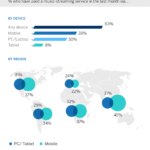World Voice Day also celebrates the union of music and technology
The Walkman, MP3s, outdoor music festivals, intimate music venues, special meet & greet passes... Some ways to listen to music have endured, while others have evolved over time, and still others have disappeared. What is clear is that this art form has cemented its position online. It seems music triumphs in both hearts and web pages.

Reliving the Back Street Boys’ fan phenomena with unprecedented concerts and documentaries on platforms like YouTube, checking out the video clip of ‘Love of Lesbian’ with virtual reality glasses, or living the experience of a concert free of charge (backstage access and rehearsals included) are only possible thanks to the advances made by the internet. Today, World Music Day, music and technology are in perfect harmony.
From Audiogalaxy to freemium service
There are thousands of music streaming platforms that can be accessed not only on a computer but also on tablets, smartphones and even wearables. The content of thousands of CDs that used to take up space on bookshelves around the world can now be kept on playlists that take up less than 1GB of memory. But what seems like a new phenomenon, actually now marks its twentieth anniversary.
In 1998, Michael Merhej launched AudioGalaxy, an online MP3 search engine. Two years later, Sony inaugurated its online music store where songs went for $3.50. In 2001, Rhapsody entered the market as the first music streaming platform with a monthly subscription fee. Currently, almost all the music services that were created in the first decade of this century lag behind the internet giants with their mobile applications: Spotify, Google Play Music and Apple Music.
Spotify was founded in 2008, Google’s music service in 2011 and Apple Music arrived four years later. These three online music providers are the best known and most downloaded. They've pooled more than 30 million songs, and the premium subscription price is the same for each. That’s where the similarities end.
Apple and Google resemble each other more. Neither offers a free subscription model. Both let customers upload MP3s to create their own music library. Spotify, on the other hand, offers what they call a freemium service as one of two choices for its customers: a paid version with access to an extensive downloadable music library and the free freemium version, which has certain restrictions like advertisements between songs. Spotify is also an example of a data-driven company, using customer data to improve its service: the platform recommends songs according to user history and playlists. They even consider a customer's age because different generations follow different trends when it comes to streaming music.
Generations Y & Z stream the most music
For as much as the format or style of composers might change, the appetite for music is not bound by age. Baby Boomers and Xennials alike consume music on their mobile devices, as detailed by this report produced by Globalwebindex with conclusions derived from surveys of more than 70,000 people between the ages of 16 and 64.

Stream music around the world - GlobalWebIndex
This study reveals that more than a third of the participants listen to music on their phone while more than half are indifferent to the device they use. Respondents’ respective geographic areas influenced the answers: in Europe the laptop computer is used more than the phone to listen to music, whereas in Latin America, the mobile phone is the clear winner.
It is also proven that geography plays a role in the musical consumption of millennials. Europeans stream the least (less than 65 minutes a day). North Americans lead the ranking with almost two hours of listening per day.
Additionally, older listeners are less likely to pay for a service that can be had for free. Around 21% of centennials and millennials are willing to pay for music streaming. Whereas in the over-55 age group, the figure sits at only 6%. Either to enjoy certain advantages or to avoid advertisements, some listeners prefer to pay the monthly subscription fee, making the move from ‘freemium’ to premium.
Among both older generations and the youth, music plays a day-in-day-out role in society and culture. When people began connecting to the internet, musical content didn't want to miss the boat that streaming offered. Although there is much yet to be developed, music has already claimed its space on every screen with an internet connection.